Religion in the Workplace
VerifiedAdded on 2023/03/21
|16
|4132
|84
AI Summary
This paper explores the impact of religion in the workplace and its effects on diversity and performance. It discusses the challenges and benefits of managing religious diversity in business enterprises, with a focus on the Australian context. The paper also examines factors that affect the attainment of religious diversity within the workplace, such as organizational culture, employees, clientele, and job design.
Contribute Materials
Your contribution can guide someone’s learning journey. Share your
documents today.
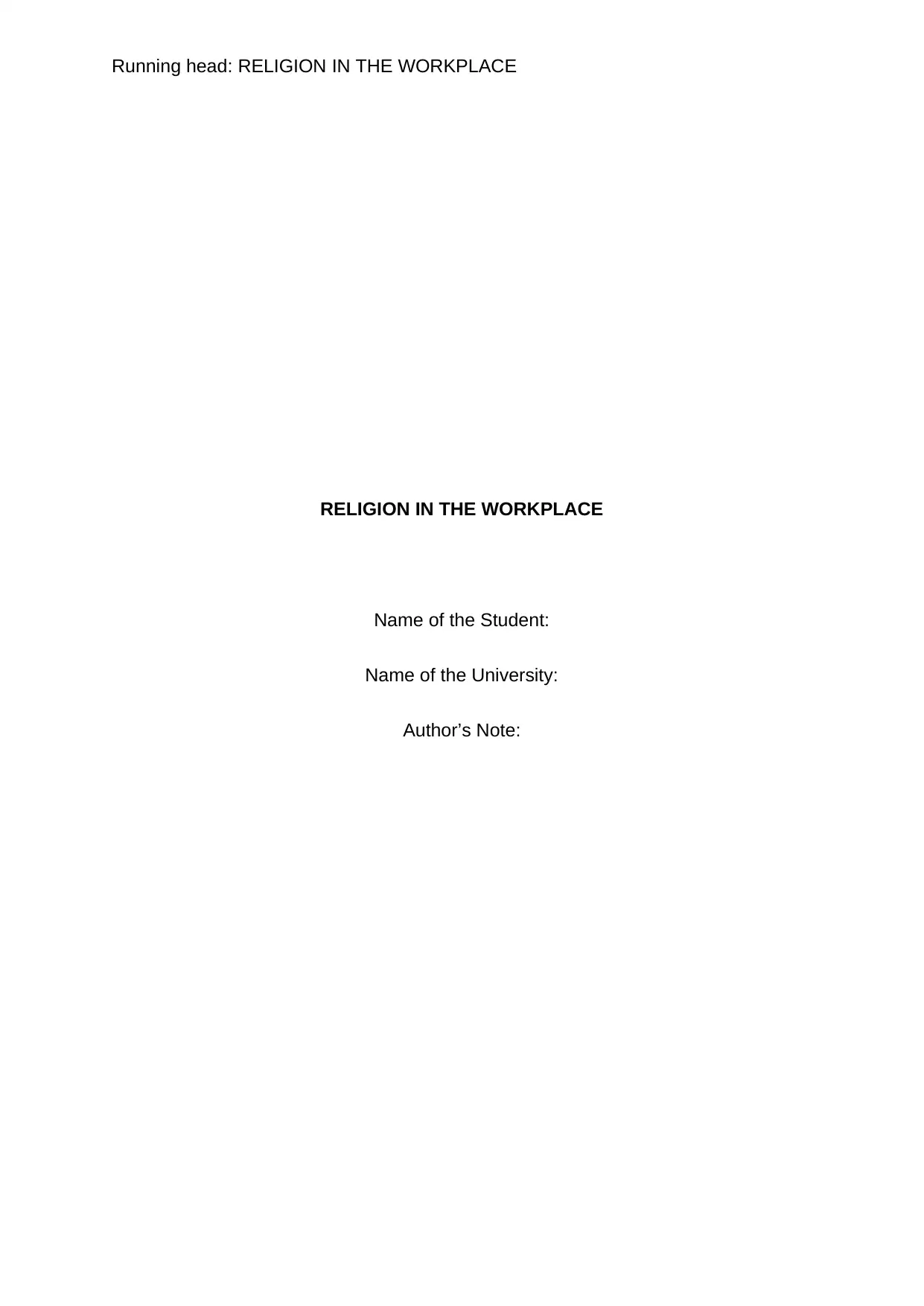
Running head: RELIGION IN THE WORKPLACE
RELIGION IN THE WORKPLACE
Name of the Student:
Name of the University:
Author’s Note:
RELIGION IN THE WORKPLACE
Name of the Student:
Name of the University:
Author’s Note:
Secure Best Marks with AI Grader
Need help grading? Try our AI Grader for instant feedback on your assignments.
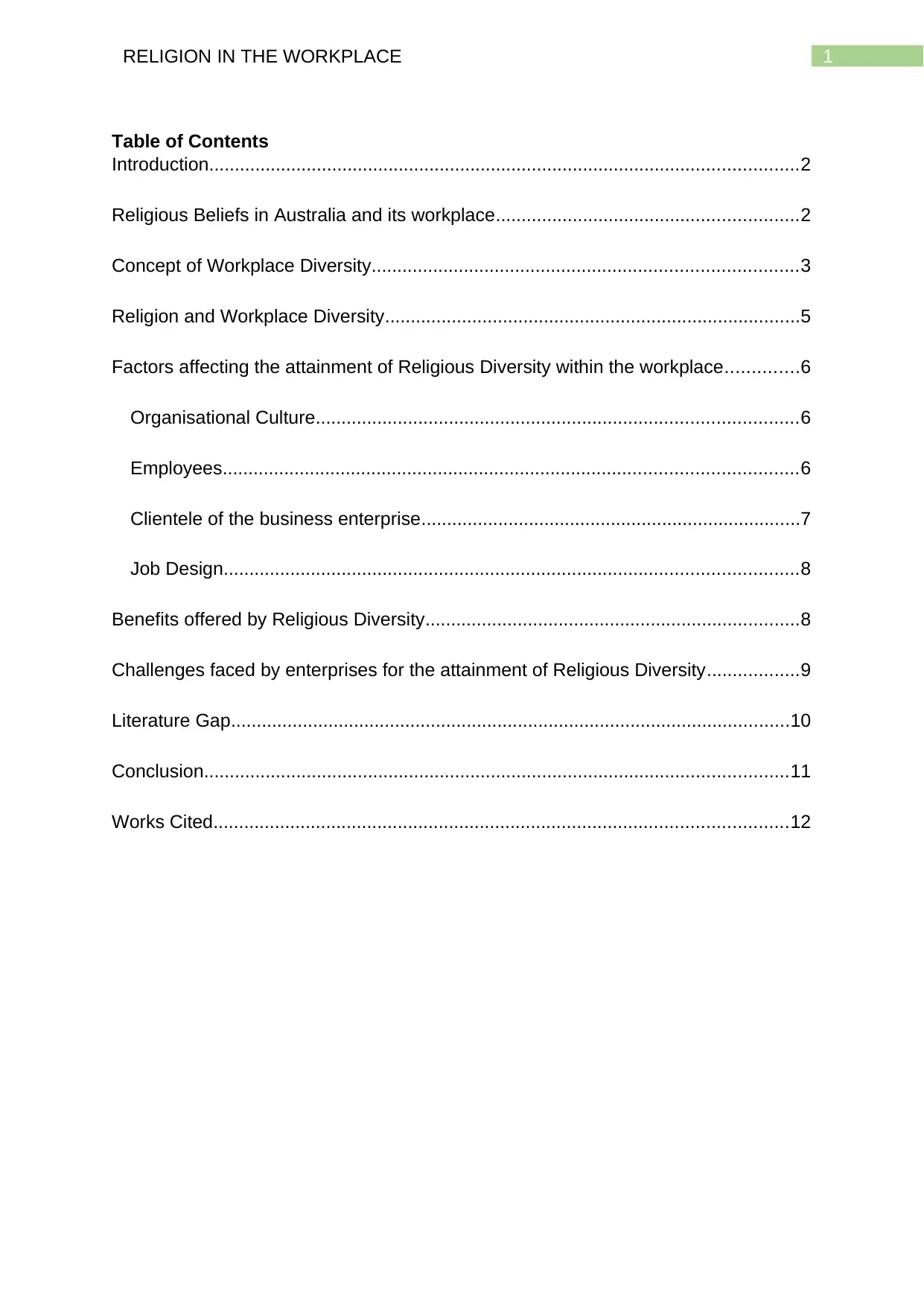
1RELIGION IN THE WORKPLACE
Table of Contents
Introduction...................................................................................................................2
Religious Beliefs in Australia and its workplace...........................................................2
Concept of Workplace Diversity...................................................................................3
Religion and Workplace Diversity.................................................................................5
Factors affecting the attainment of Religious Diversity within the workplace..............6
Organisational Culture..............................................................................................6
Employees................................................................................................................6
Clientele of the business enterprise..........................................................................7
Job Design................................................................................................................8
Benefits offered by Religious Diversity.........................................................................8
Challenges faced by enterprises for the attainment of Religious Diversity..................9
Literature Gap.............................................................................................................10
Conclusion..................................................................................................................11
Works Cited................................................................................................................12
Table of Contents
Introduction...................................................................................................................2
Religious Beliefs in Australia and its workplace...........................................................2
Concept of Workplace Diversity...................................................................................3
Religion and Workplace Diversity.................................................................................5
Factors affecting the attainment of Religious Diversity within the workplace..............6
Organisational Culture..............................................................................................6
Employees................................................................................................................6
Clientele of the business enterprise..........................................................................7
Job Design................................................................................................................8
Benefits offered by Religious Diversity.........................................................................8
Challenges faced by enterprises for the attainment of Religious Diversity..................9
Literature Gap.............................................................................................................10
Conclusion..................................................................................................................11
Works Cited................................................................................................................12
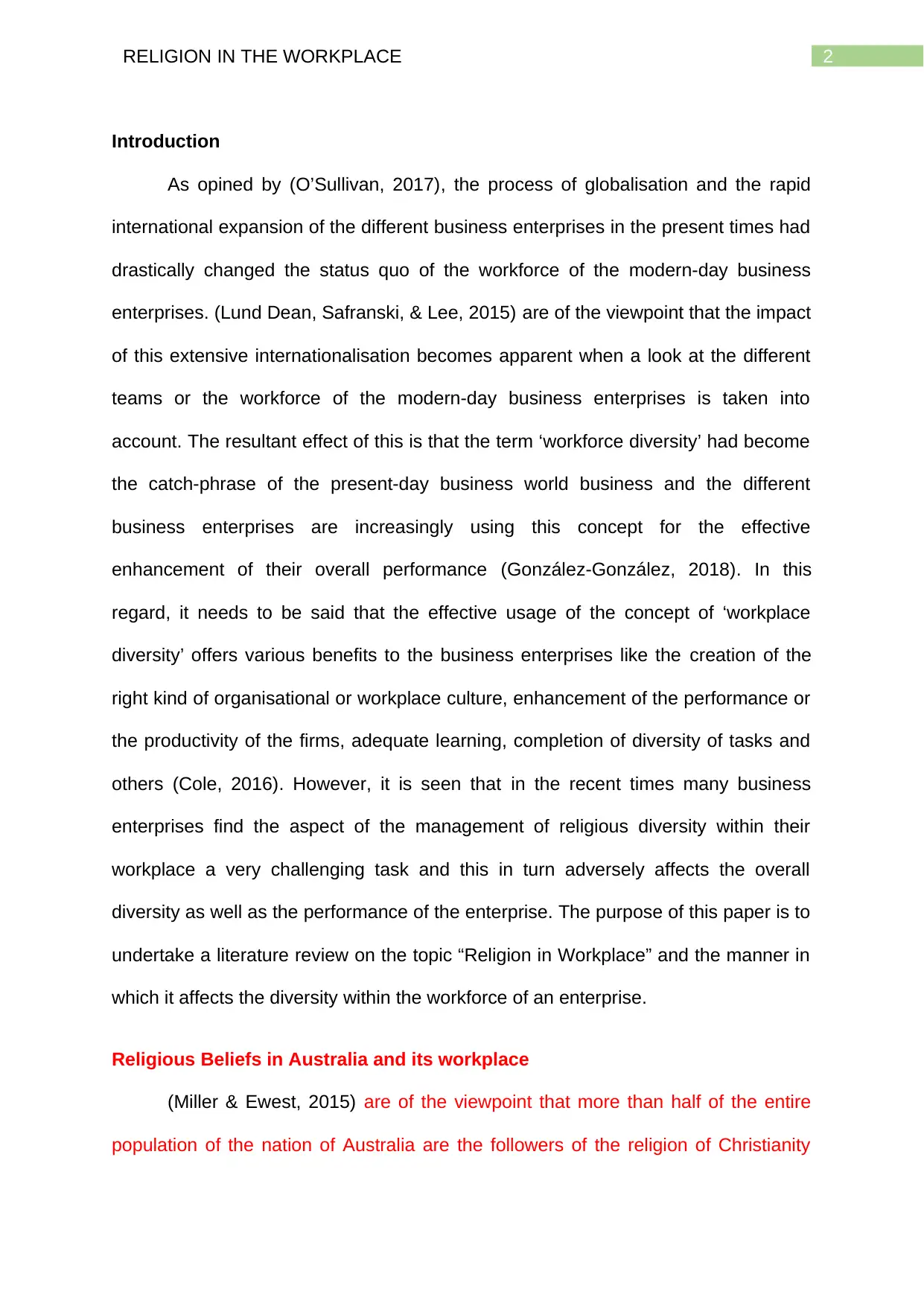
2RELIGION IN THE WORKPLACE
Introduction
As opined by (O’Sullivan, 2017), the process of globalisation and the rapid
international expansion of the different business enterprises in the present times had
drastically changed the status quo of the workforce of the modern-day business
enterprises. (Lund Dean, Safranski, & Lee, 2015) are of the viewpoint that the impact
of this extensive internationalisation becomes apparent when a look at the different
teams or the workforce of the modern-day business enterprises is taken into
account. The resultant effect of this is that the term ‘workforce diversity’ had become
the catch-phrase of the present-day business world business and the different
business enterprises are increasingly using this concept for the effective
enhancement of their overall performance (González-González, 2018). In this
regard, it needs to be said that the effective usage of the concept of ‘workplace
diversity’ offers various benefits to the business enterprises like the creation of the
right kind of organisational or workplace culture, enhancement of the performance or
the productivity of the firms, adequate learning, completion of diversity of tasks and
others (Cole, 2016). However, it is seen that in the recent times many business
enterprises find the aspect of the management of religious diversity within their
workplace a very challenging task and this in turn adversely affects the overall
diversity as well as the performance of the enterprise. The purpose of this paper is to
undertake a literature review on the topic “Religion in Workplace” and the manner in
which it affects the diversity within the workforce of an enterprise.
Religious Beliefs in Australia and its workplace
(Miller & Ewest, 2015) are of the viewpoint that more than half of the entire
population of the nation of Australia are the followers of the religion of Christianity
Introduction
As opined by (O’Sullivan, 2017), the process of globalisation and the rapid
international expansion of the different business enterprises in the present times had
drastically changed the status quo of the workforce of the modern-day business
enterprises. (Lund Dean, Safranski, & Lee, 2015) are of the viewpoint that the impact
of this extensive internationalisation becomes apparent when a look at the different
teams or the workforce of the modern-day business enterprises is taken into
account. The resultant effect of this is that the term ‘workforce diversity’ had become
the catch-phrase of the present-day business world business and the different
business enterprises are increasingly using this concept for the effective
enhancement of their overall performance (González-González, 2018). In this
regard, it needs to be said that the effective usage of the concept of ‘workplace
diversity’ offers various benefits to the business enterprises like the creation of the
right kind of organisational or workplace culture, enhancement of the performance or
the productivity of the firms, adequate learning, completion of diversity of tasks and
others (Cole, 2016). However, it is seen that in the recent times many business
enterprises find the aspect of the management of religious diversity within their
workplace a very challenging task and this in turn adversely affects the overall
diversity as well as the performance of the enterprise. The purpose of this paper is to
undertake a literature review on the topic “Religion in Workplace” and the manner in
which it affects the diversity within the workforce of an enterprise.
Religious Beliefs in Australia and its workplace
(Miller & Ewest, 2015) are of the viewpoint that more than half of the entire
population of the nation of Australia are the followers of the religion of Christianity
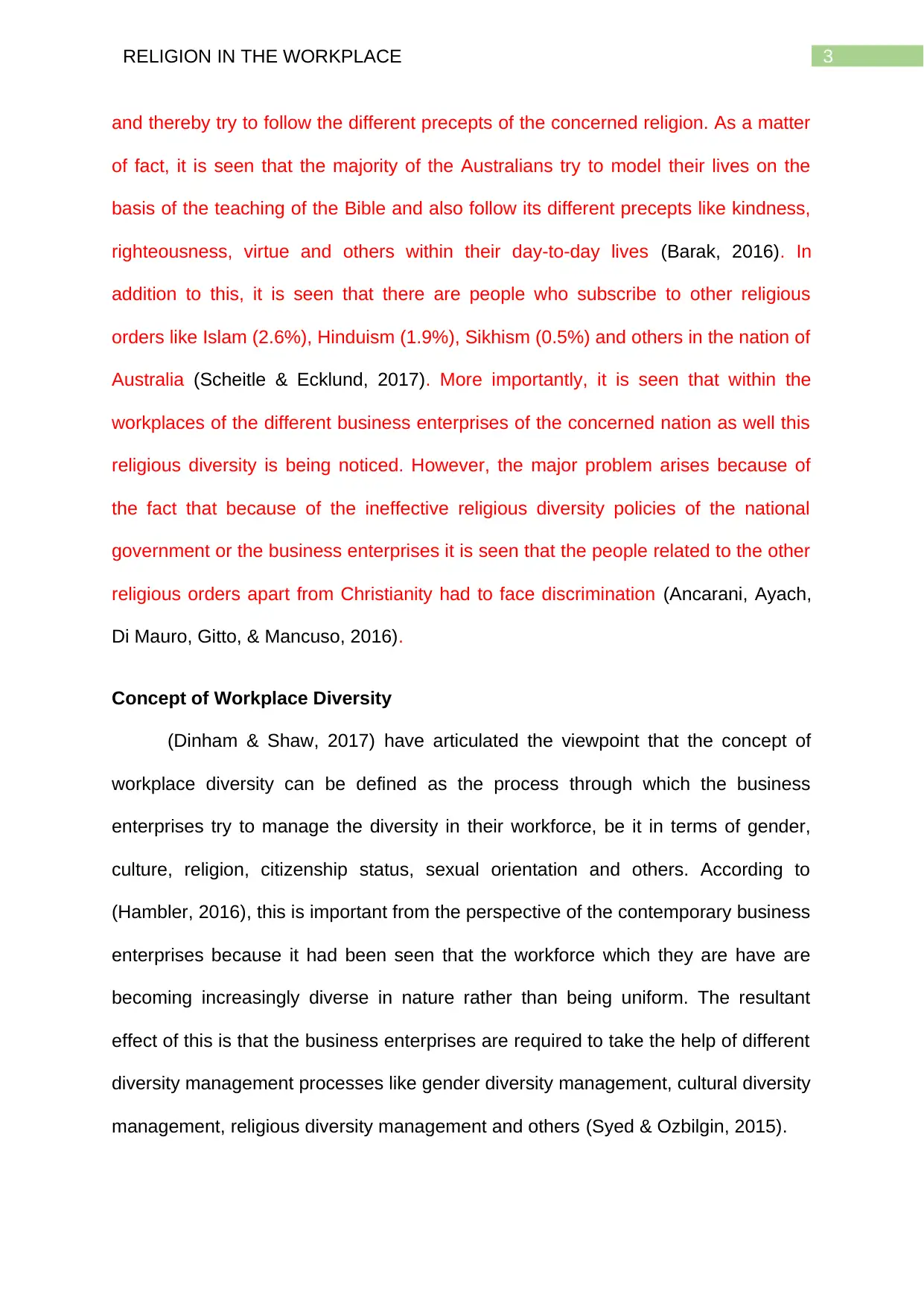
3RELIGION IN THE WORKPLACE
and thereby try to follow the different precepts of the concerned religion. As a matter
of fact, it is seen that the majority of the Australians try to model their lives on the
basis of the teaching of the Bible and also follow its different precepts like kindness,
righteousness, virtue and others within their day-to-day lives (Barak, 2016). In
addition to this, it is seen that there are people who subscribe to other religious
orders like Islam (2.6%), Hinduism (1.9%), Sikhism (0.5%) and others in the nation of
Australia (Scheitle & Ecklund, 2017). More importantly, it is seen that within the
workplaces of the different business enterprises of the concerned nation as well this
religious diversity is being noticed. However, the major problem arises because of
the fact that because of the ineffective religious diversity policies of the national
government or the business enterprises it is seen that the people related to the other
religious orders apart from Christianity had to face discrimination (Ancarani, Ayach,
Di Mauro, Gitto, & Mancuso, 2016).
Concept of Workplace Diversity
(Dinham & Shaw, 2017) have articulated the viewpoint that the concept of
workplace diversity can be defined as the process through which the business
enterprises try to manage the diversity in their workforce, be it in terms of gender,
culture, religion, citizenship status, sexual orientation and others. According to
(Hambler, 2016), this is important from the perspective of the contemporary business
enterprises because it had been seen that the workforce which they are have are
becoming increasingly diverse in nature rather than being uniform. The resultant
effect of this is that the business enterprises are required to take the help of different
diversity management processes like gender diversity management, cultural diversity
management, religious diversity management and others (Syed & Ozbilgin, 2015).
and thereby try to follow the different precepts of the concerned religion. As a matter
of fact, it is seen that the majority of the Australians try to model their lives on the
basis of the teaching of the Bible and also follow its different precepts like kindness,
righteousness, virtue and others within their day-to-day lives (Barak, 2016). In
addition to this, it is seen that there are people who subscribe to other religious
orders like Islam (2.6%), Hinduism (1.9%), Sikhism (0.5%) and others in the nation of
Australia (Scheitle & Ecklund, 2017). More importantly, it is seen that within the
workplaces of the different business enterprises of the concerned nation as well this
religious diversity is being noticed. However, the major problem arises because of
the fact that because of the ineffective religious diversity policies of the national
government or the business enterprises it is seen that the people related to the other
religious orders apart from Christianity had to face discrimination (Ancarani, Ayach,
Di Mauro, Gitto, & Mancuso, 2016).
Concept of Workplace Diversity
(Dinham & Shaw, 2017) have articulated the viewpoint that the concept of
workplace diversity can be defined as the process through which the business
enterprises try to manage the diversity in their workforce, be it in terms of gender,
culture, religion, citizenship status, sexual orientation and others. According to
(Hambler, 2016), this is important from the perspective of the contemporary business
enterprises because it had been seen that the workforce which they are have are
becoming increasingly diverse in nature rather than being uniform. The resultant
effect of this is that the business enterprises are required to take the help of different
diversity management processes like gender diversity management, cultural diversity
management, religious diversity management and others (Syed & Ozbilgin, 2015).
Secure Best Marks with AI Grader
Need help grading? Try our AI Grader for instant feedback on your assignments.
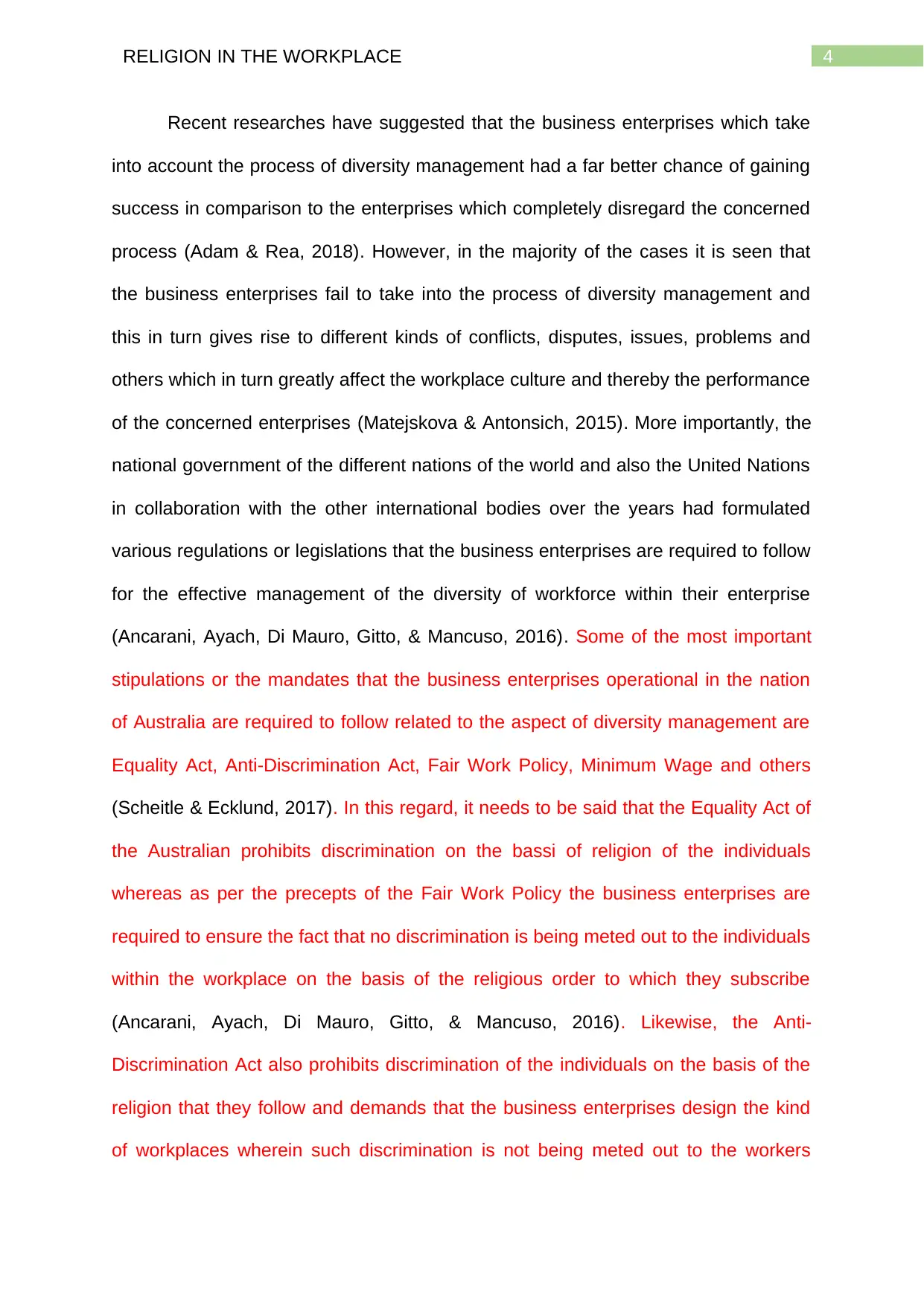
4RELIGION IN THE WORKPLACE
Recent researches have suggested that the business enterprises which take
into account the process of diversity management had a far better chance of gaining
success in comparison to the enterprises which completely disregard the concerned
process (Adam & Rea, 2018). However, in the majority of the cases it is seen that
the business enterprises fail to take into the process of diversity management and
this in turn gives rise to different kinds of conflicts, disputes, issues, problems and
others which in turn greatly affect the workplace culture and thereby the performance
of the concerned enterprises (Matejskova & Antonsich, 2015). More importantly, the
national government of the different nations of the world and also the United Nations
in collaboration with the other international bodies over the years had formulated
various regulations or legislations that the business enterprises are required to follow
for the effective management of the diversity of workforce within their enterprise
(Ancarani, Ayach, Di Mauro, Gitto, & Mancuso, 2016). Some of the most important
stipulations or the mandates that the business enterprises operational in the nation
of Australia are required to follow related to the aspect of diversity management are
Equality Act, Anti-Discrimination Act, Fair Work Policy, Minimum Wage and others
(Scheitle & Ecklund, 2017). In this regard, it needs to be said that the Equality Act of
the Australian prohibits discrimination on the bassi of religion of the individuals
whereas as per the precepts of the Fair Work Policy the business enterprises are
required to ensure the fact that no discrimination is being meted out to the individuals
within the workplace on the basis of the religious order to which they subscribe
(Ancarani, Ayach, Di Mauro, Gitto, & Mancuso, 2016). Likewise, the Anti-
Discrimination Act also prohibits discrimination of the individuals on the basis of the
religion that they follow and demands that the business enterprises design the kind
of workplaces wherein such discrimination is not being meted out to the workers
Recent researches have suggested that the business enterprises which take
into account the process of diversity management had a far better chance of gaining
success in comparison to the enterprises which completely disregard the concerned
process (Adam & Rea, 2018). However, in the majority of the cases it is seen that
the business enterprises fail to take into the process of diversity management and
this in turn gives rise to different kinds of conflicts, disputes, issues, problems and
others which in turn greatly affect the workplace culture and thereby the performance
of the concerned enterprises (Matejskova & Antonsich, 2015). More importantly, the
national government of the different nations of the world and also the United Nations
in collaboration with the other international bodies over the years had formulated
various regulations or legislations that the business enterprises are required to follow
for the effective management of the diversity of workforce within their enterprise
(Ancarani, Ayach, Di Mauro, Gitto, & Mancuso, 2016). Some of the most important
stipulations or the mandates that the business enterprises operational in the nation
of Australia are required to follow related to the aspect of diversity management are
Equality Act, Anti-Discrimination Act, Fair Work Policy, Minimum Wage and others
(Scheitle & Ecklund, 2017). In this regard, it needs to be said that the Equality Act of
the Australian prohibits discrimination on the bassi of religion of the individuals
whereas as per the precepts of the Fair Work Policy the business enterprises are
required to ensure the fact that no discrimination is being meted out to the individuals
within the workplace on the basis of the religious order to which they subscribe
(Ancarani, Ayach, Di Mauro, Gitto, & Mancuso, 2016). Likewise, the Anti-
Discrimination Act also prohibits discrimination of the individuals on the basis of the
religion that they follow and demands that the business enterprises design the kind
of workplaces wherein such discrimination is not being meted out to the workers
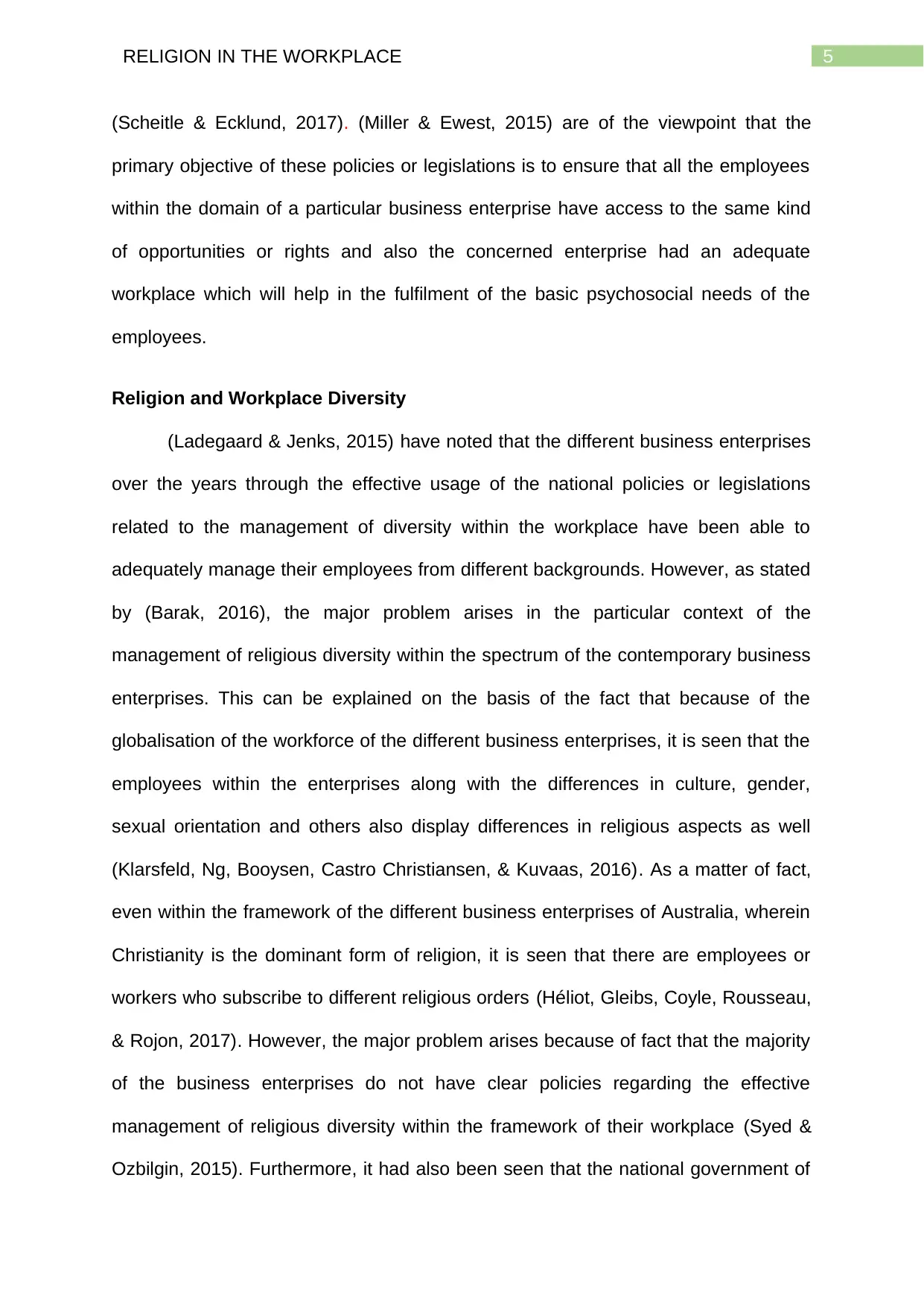
5RELIGION IN THE WORKPLACE
(Scheitle & Ecklund, 2017). (Miller & Ewest, 2015) are of the viewpoint that the
primary objective of these policies or legislations is to ensure that all the employees
within the domain of a particular business enterprise have access to the same kind
of opportunities or rights and also the concerned enterprise had an adequate
workplace which will help in the fulfilment of the basic psychosocial needs of the
employees.
Religion and Workplace Diversity
(Ladegaard & Jenks, 2015) have noted that the different business enterprises
over the years through the effective usage of the national policies or legislations
related to the management of diversity within the workplace have been able to
adequately manage their employees from different backgrounds. However, as stated
by (Barak, 2016), the major problem arises in the particular context of the
management of religious diversity within the spectrum of the contemporary business
enterprises. This can be explained on the basis of the fact that because of the
globalisation of the workforce of the different business enterprises, it is seen that the
employees within the enterprises along with the differences in culture, gender,
sexual orientation and others also display differences in religious aspects as well
(Klarsfeld, Ng, Booysen, Castro Christiansen, & Kuvaas, 2016). As a matter of fact,
even within the framework of the different business enterprises of Australia, wherein
Christianity is the dominant form of religion, it is seen that there are employees or
workers who subscribe to different religious orders (Héliot, Gleibs, Coyle, Rousseau,
& Rojon, 2017). However, the major problem arises because of fact that the majority
of the business enterprises do not have clear policies regarding the effective
management of religious diversity within the framework of their workplace (Syed &
Ozbilgin, 2015). Furthermore, it had also been seen that the national government of
(Scheitle & Ecklund, 2017). (Miller & Ewest, 2015) are of the viewpoint that the
primary objective of these policies or legislations is to ensure that all the employees
within the domain of a particular business enterprise have access to the same kind
of opportunities or rights and also the concerned enterprise had an adequate
workplace which will help in the fulfilment of the basic psychosocial needs of the
employees.
Religion and Workplace Diversity
(Ladegaard & Jenks, 2015) have noted that the different business enterprises
over the years through the effective usage of the national policies or legislations
related to the management of diversity within the workplace have been able to
adequately manage their employees from different backgrounds. However, as stated
by (Barak, 2016), the major problem arises in the particular context of the
management of religious diversity within the spectrum of the contemporary business
enterprises. This can be explained on the basis of the fact that because of the
globalisation of the workforce of the different business enterprises, it is seen that the
employees within the enterprises along with the differences in culture, gender,
sexual orientation and others also display differences in religious aspects as well
(Klarsfeld, Ng, Booysen, Castro Christiansen, & Kuvaas, 2016). As a matter of fact,
even within the framework of the different business enterprises of Australia, wherein
Christianity is the dominant form of religion, it is seen that there are employees or
workers who subscribe to different religious orders (Héliot, Gleibs, Coyle, Rousseau,
& Rojon, 2017). However, the major problem arises because of fact that the majority
of the business enterprises do not have clear policies regarding the effective
management of religious diversity within the framework of their workplace (Syed &
Ozbilgin, 2015). Furthermore, it had also been seen that the national government of

6RELIGION IN THE WORKPLACE
Australia as well even in the present times had not formulated any effective
legislation or policy for the management of religious diversity within the business
enterprises (Al Ariss & Sidani, 2016). These in turn had led to the ineffective
management of religious diversity within the spectrum of the different contemporary
business enterprises of the nation of Australia.
Factors affecting the attainment of Religious Diversity within the workplace
There are various factors which affect the effective attainment of religious
diversity within the spectrum of the contemporary business enterprises. Some of the
most important factors are discussed below-
Organisational Culture
(Gröschl & Bendl, 2015) have articulated the viewpoint that an important
factor which affects the effective usage of religious diversity within the mould of
different business enterprises is the entity of organisational or workplace culture.
According to (Foblets & Alidadi, 2016), the entity of organisational or workplace
culture wield a substantial amount of influence on the employees or the workers of
an enterprise and also moulds their behaviour greatly. In this regard, it needs to be
said that if a business enterprise follows a liberal workplace culture wherein the
different employees or the workers would be given the freedom to practice the kind
of religion that they want interfering with the ones followed by the others then it is
likely that the concerned workplace or enterprise would be able to attain religious
diversity in an effective manner (Barak, 2016).
Employees
According to (Cole, 2016), the level of religious diversity that a particular
workplace or enterprise would have significantly depends on the nature or the kind of
Australia as well even in the present times had not formulated any effective
legislation or policy for the management of religious diversity within the business
enterprises (Al Ariss & Sidani, 2016). These in turn had led to the ineffective
management of religious diversity within the spectrum of the different contemporary
business enterprises of the nation of Australia.
Factors affecting the attainment of Religious Diversity within the workplace
There are various factors which affect the effective attainment of religious
diversity within the spectrum of the contemporary business enterprises. Some of the
most important factors are discussed below-
Organisational Culture
(Gröschl & Bendl, 2015) have articulated the viewpoint that an important
factor which affects the effective usage of religious diversity within the mould of
different business enterprises is the entity of organisational or workplace culture.
According to (Foblets & Alidadi, 2016), the entity of organisational or workplace
culture wield a substantial amount of influence on the employees or the workers of
an enterprise and also moulds their behaviour greatly. In this regard, it needs to be
said that if a business enterprise follows a liberal workplace culture wherein the
different employees or the workers would be given the freedom to practice the kind
of religion that they want interfering with the ones followed by the others then it is
likely that the concerned workplace or enterprise would be able to attain religious
diversity in an effective manner (Barak, 2016).
Employees
According to (Cole, 2016), the level of religious diversity that a particular
workplace or enterprise would have significantly depends on the nature or the kind of
Paraphrase This Document
Need a fresh take? Get an instant paraphrase of this document with our AI Paraphraser
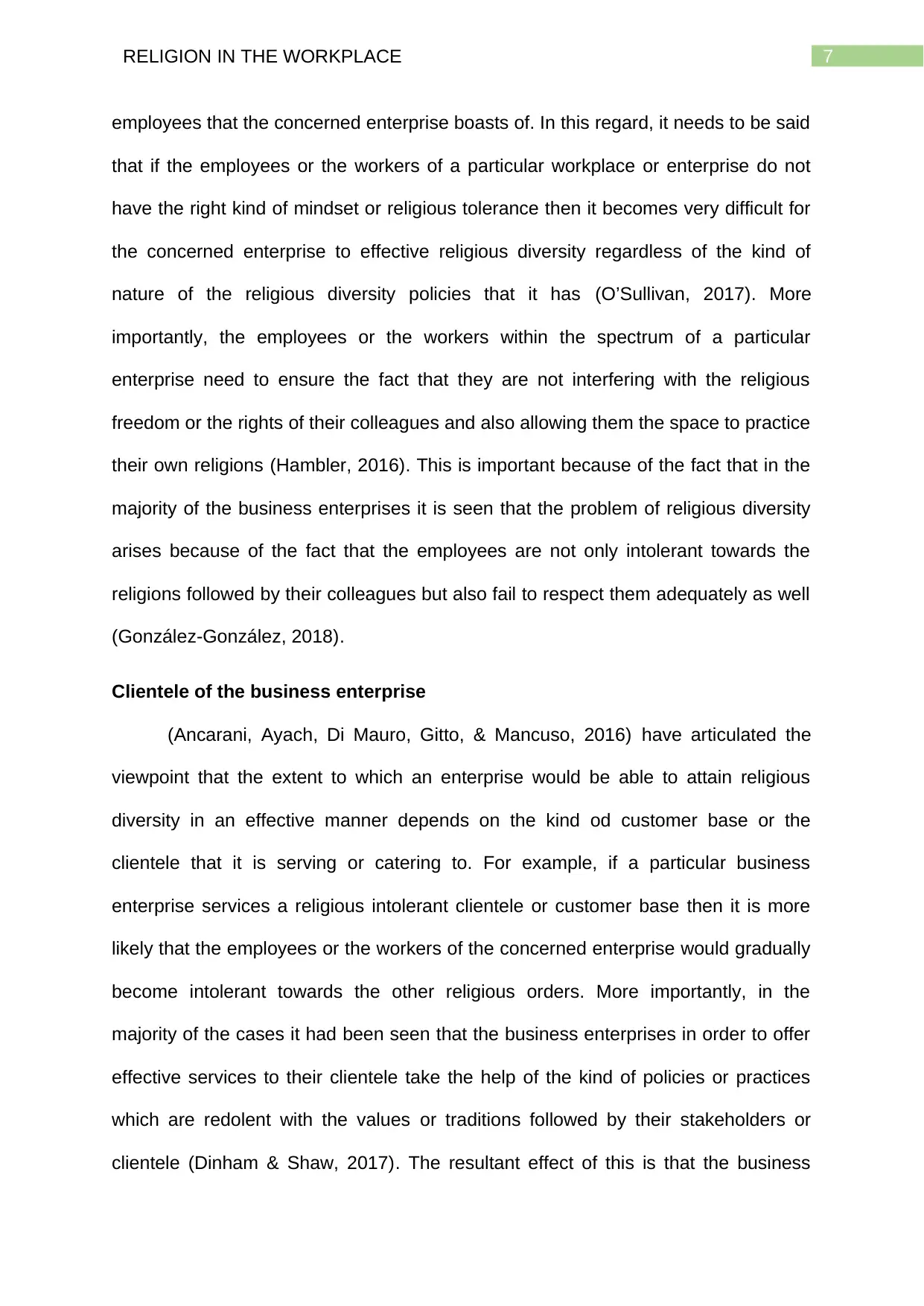
7RELIGION IN THE WORKPLACE
employees that the concerned enterprise boasts of. In this regard, it needs to be said
that if the employees or the workers of a particular workplace or enterprise do not
have the right kind of mindset or religious tolerance then it becomes very difficult for
the concerned enterprise to effective religious diversity regardless of the kind of
nature of the religious diversity policies that it has (O’Sullivan, 2017). More
importantly, the employees or the workers within the spectrum of a particular
enterprise need to ensure the fact that they are not interfering with the religious
freedom or the rights of their colleagues and also allowing them the space to practice
their own religions (Hambler, 2016). This is important because of the fact that in the
majority of the business enterprises it is seen that the problem of religious diversity
arises because of the fact that the employees are not only intolerant towards the
religions followed by their colleagues but also fail to respect them adequately as well
(González-González, 2018).
Clientele of the business enterprise
(Ancarani, Ayach, Di Mauro, Gitto, & Mancuso, 2016) have articulated the
viewpoint that the extent to which an enterprise would be able to attain religious
diversity in an effective manner depends on the kind od customer base or the
clientele that it is serving or catering to. For example, if a particular business
enterprise services a religious intolerant clientele or customer base then it is more
likely that the employees or the workers of the concerned enterprise would gradually
become intolerant towards the other religious orders. More importantly, in the
majority of the cases it had been seen that the business enterprises in order to offer
effective services to their clientele take the help of the kind of policies or practices
which are redolent with the values or traditions followed by their stakeholders or
clientele (Dinham & Shaw, 2017). The resultant effect of this is that the business
employees that the concerned enterprise boasts of. In this regard, it needs to be said
that if the employees or the workers of a particular workplace or enterprise do not
have the right kind of mindset or religious tolerance then it becomes very difficult for
the concerned enterprise to effective religious diversity regardless of the kind of
nature of the religious diversity policies that it has (O’Sullivan, 2017). More
importantly, the employees or the workers within the spectrum of a particular
enterprise need to ensure the fact that they are not interfering with the religious
freedom or the rights of their colleagues and also allowing them the space to practice
their own religions (Hambler, 2016). This is important because of the fact that in the
majority of the business enterprises it is seen that the problem of religious diversity
arises because of the fact that the employees are not only intolerant towards the
religions followed by their colleagues but also fail to respect them adequately as well
(González-González, 2018).
Clientele of the business enterprise
(Ancarani, Ayach, Di Mauro, Gitto, & Mancuso, 2016) have articulated the
viewpoint that the extent to which an enterprise would be able to attain religious
diversity in an effective manner depends on the kind od customer base or the
clientele that it is serving or catering to. For example, if a particular business
enterprise services a religious intolerant clientele or customer base then it is more
likely that the employees or the workers of the concerned enterprise would gradually
become intolerant towards the other religious orders. More importantly, in the
majority of the cases it had been seen that the business enterprises in order to offer
effective services to their clientele take the help of the kind of policies or practices
which are redolent with the values or traditions followed by their stakeholders or
clientele (Dinham & Shaw, 2017). The resultant effect of this is that the business
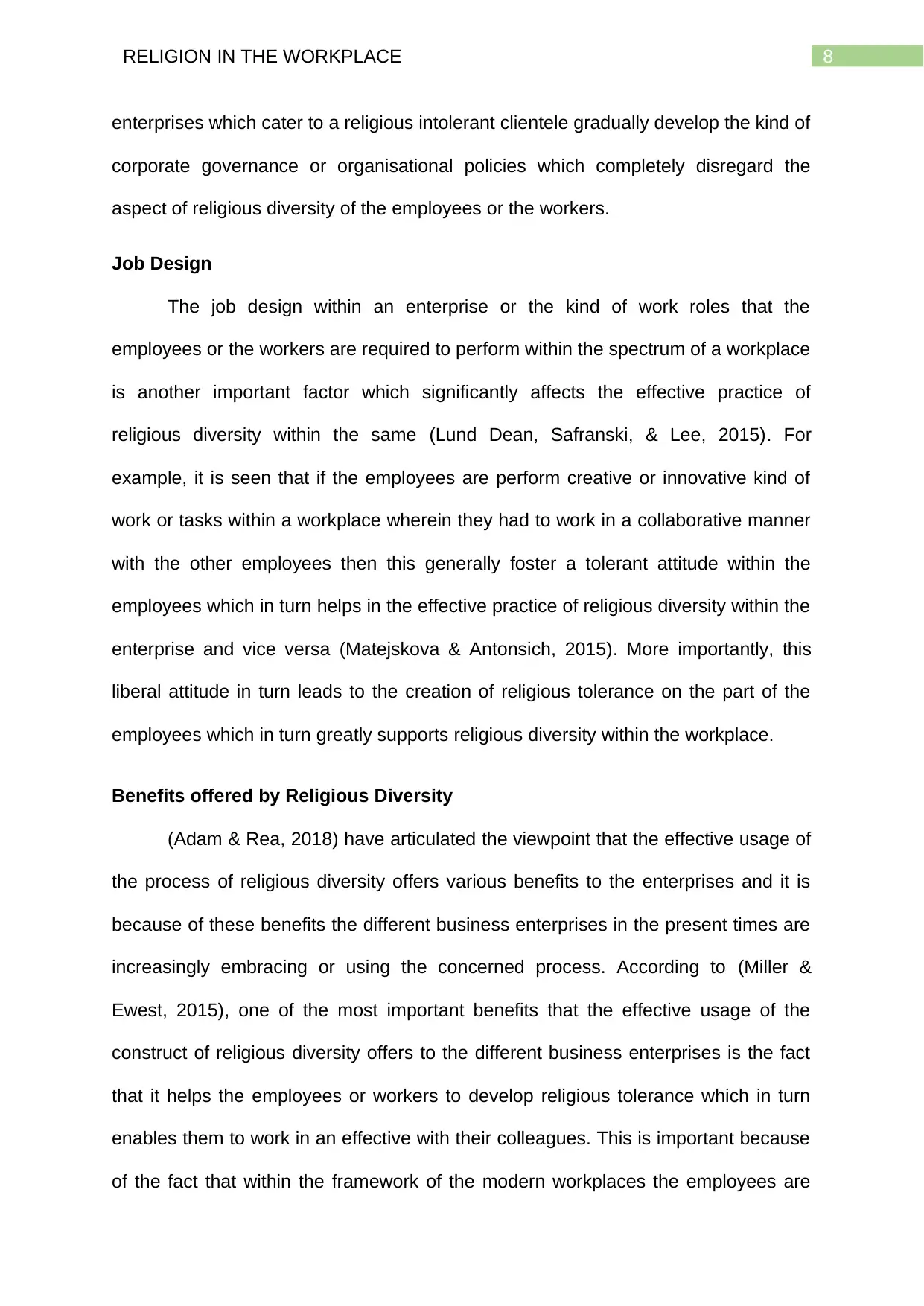
8RELIGION IN THE WORKPLACE
enterprises which cater to a religious intolerant clientele gradually develop the kind of
corporate governance or organisational policies which completely disregard the
aspect of religious diversity of the employees or the workers.
Job Design
The job design within an enterprise or the kind of work roles that the
employees or the workers are required to perform within the spectrum of a workplace
is another important factor which significantly affects the effective practice of
religious diversity within the same (Lund Dean, Safranski, & Lee, 2015). For
example, it is seen that if the employees are perform creative or innovative kind of
work or tasks within a workplace wherein they had to work in a collaborative manner
with the other employees then this generally foster a tolerant attitude within the
employees which in turn helps in the effective practice of religious diversity within the
enterprise and vice versa (Matejskova & Antonsich, 2015). More importantly, this
liberal attitude in turn leads to the creation of religious tolerance on the part of the
employees which in turn greatly supports religious diversity within the workplace.
Benefits offered by Religious Diversity
(Adam & Rea, 2018) have articulated the viewpoint that the effective usage of
the process of religious diversity offers various benefits to the enterprises and it is
because of these benefits the different business enterprises in the present times are
increasingly embracing or using the concerned process. According to (Miller &
Ewest, 2015), one of the most important benefits that the effective usage of the
construct of religious diversity offers to the different business enterprises is the fact
that it helps the employees or workers to develop religious tolerance which in turn
enables them to work in an effective with their colleagues. This is important because
of the fact that within the framework of the modern workplaces the employees are
enterprises which cater to a religious intolerant clientele gradually develop the kind of
corporate governance or organisational policies which completely disregard the
aspect of religious diversity of the employees or the workers.
Job Design
The job design within an enterprise or the kind of work roles that the
employees or the workers are required to perform within the spectrum of a workplace
is another important factor which significantly affects the effective practice of
religious diversity within the same (Lund Dean, Safranski, & Lee, 2015). For
example, it is seen that if the employees are perform creative or innovative kind of
work or tasks within a workplace wherein they had to work in a collaborative manner
with the other employees then this generally foster a tolerant attitude within the
employees which in turn helps in the effective practice of religious diversity within the
enterprise and vice versa (Matejskova & Antonsich, 2015). More importantly, this
liberal attitude in turn leads to the creation of religious tolerance on the part of the
employees which in turn greatly supports religious diversity within the workplace.
Benefits offered by Religious Diversity
(Adam & Rea, 2018) have articulated the viewpoint that the effective usage of
the process of religious diversity offers various benefits to the enterprises and it is
because of these benefits the different business enterprises in the present times are
increasingly embracing or using the concerned process. According to (Miller &
Ewest, 2015), one of the most important benefits that the effective usage of the
construct of religious diversity offers to the different business enterprises is the fact
that it helps the employees or workers to develop religious tolerance which in turn
enables them to work in an effective with their colleagues. This is important because
of the fact that within the framework of the modern workplaces the employees are
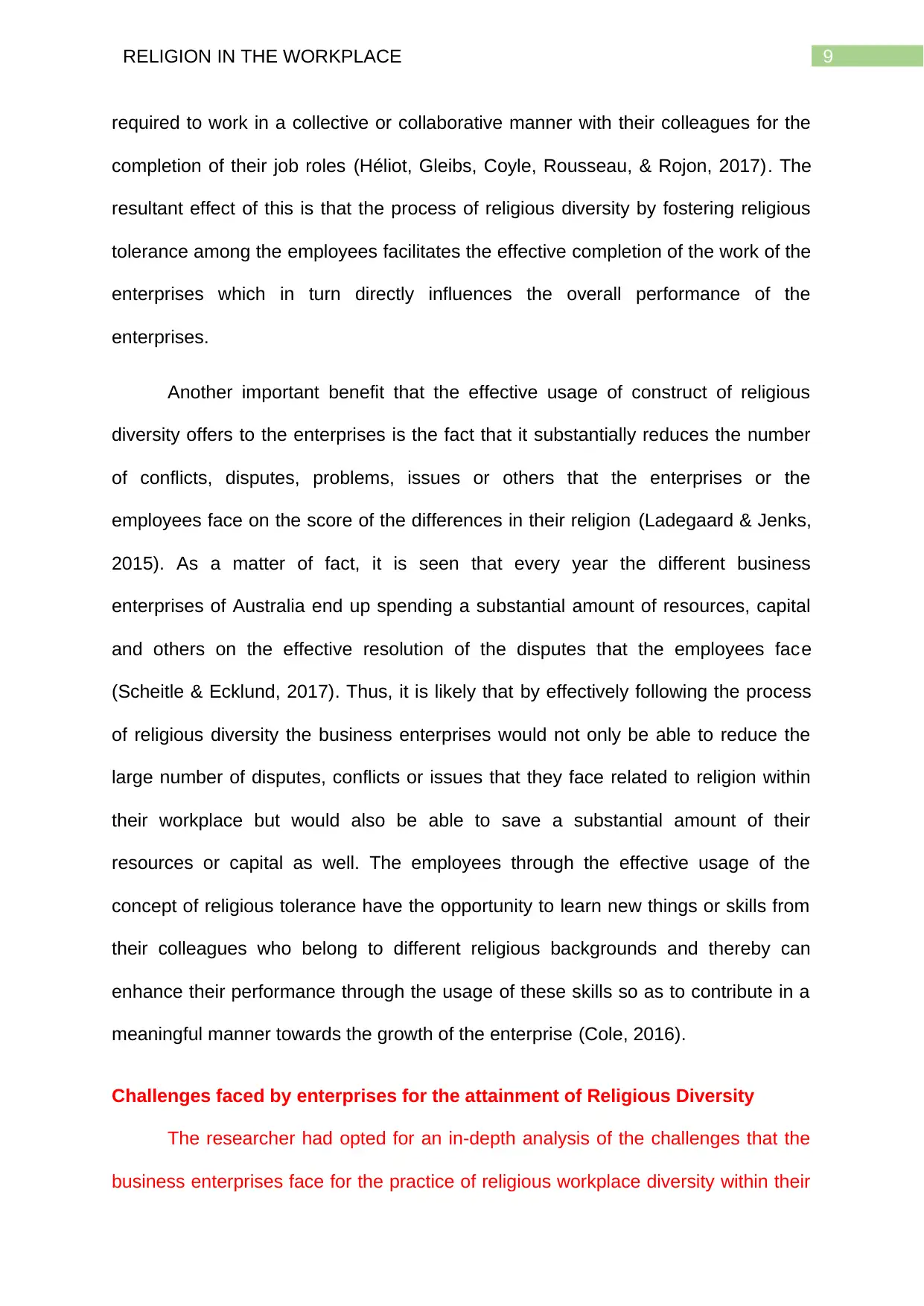
9RELIGION IN THE WORKPLACE
required to work in a collective or collaborative manner with their colleagues for the
completion of their job roles (Héliot, Gleibs, Coyle, Rousseau, & Rojon, 2017). The
resultant effect of this is that the process of religious diversity by fostering religious
tolerance among the employees facilitates the effective completion of the work of the
enterprises which in turn directly influences the overall performance of the
enterprises.
Another important benefit that the effective usage of construct of religious
diversity offers to the enterprises is the fact that it substantially reduces the number
of conflicts, disputes, problems, issues or others that the enterprises or the
employees face on the score of the differences in their religion (Ladegaard & Jenks,
2015). As a matter of fact, it is seen that every year the different business
enterprises of Australia end up spending a substantial amount of resources, capital
and others on the effective resolution of the disputes that the employees face
(Scheitle & Ecklund, 2017). Thus, it is likely that by effectively following the process
of religious diversity the business enterprises would not only be able to reduce the
large number of disputes, conflicts or issues that they face related to religion within
their workplace but would also be able to save a substantial amount of their
resources or capital as well. The employees through the effective usage of the
concept of religious tolerance have the opportunity to learn new things or skills from
their colleagues who belong to different religious backgrounds and thereby can
enhance their performance through the usage of these skills so as to contribute in a
meaningful manner towards the growth of the enterprise (Cole, 2016).
Challenges faced by enterprises for the attainment of Religious Diversity
The researcher had opted for an in-depth analysis of the challenges that the
business enterprises face for the practice of religious workplace diversity within their
required to work in a collective or collaborative manner with their colleagues for the
completion of their job roles (Héliot, Gleibs, Coyle, Rousseau, & Rojon, 2017). The
resultant effect of this is that the process of religious diversity by fostering religious
tolerance among the employees facilitates the effective completion of the work of the
enterprises which in turn directly influences the overall performance of the
enterprises.
Another important benefit that the effective usage of construct of religious
diversity offers to the enterprises is the fact that it substantially reduces the number
of conflicts, disputes, problems, issues or others that the enterprises or the
employees face on the score of the differences in their religion (Ladegaard & Jenks,
2015). As a matter of fact, it is seen that every year the different business
enterprises of Australia end up spending a substantial amount of resources, capital
and others on the effective resolution of the disputes that the employees face
(Scheitle & Ecklund, 2017). Thus, it is likely that by effectively following the process
of religious diversity the business enterprises would not only be able to reduce the
large number of disputes, conflicts or issues that they face related to religion within
their workplace but would also be able to save a substantial amount of their
resources or capital as well. The employees through the effective usage of the
concept of religious tolerance have the opportunity to learn new things or skills from
their colleagues who belong to different religious backgrounds and thereby can
enhance their performance through the usage of these skills so as to contribute in a
meaningful manner towards the growth of the enterprise (Cole, 2016).
Challenges faced by enterprises for the attainment of Religious Diversity
The researcher had opted for an in-depth analysis of the challenges that the
business enterprises face for the practice of religious workplace diversity within their
Secure Best Marks with AI Grader
Need help grading? Try our AI Grader for instant feedback on your assignments.
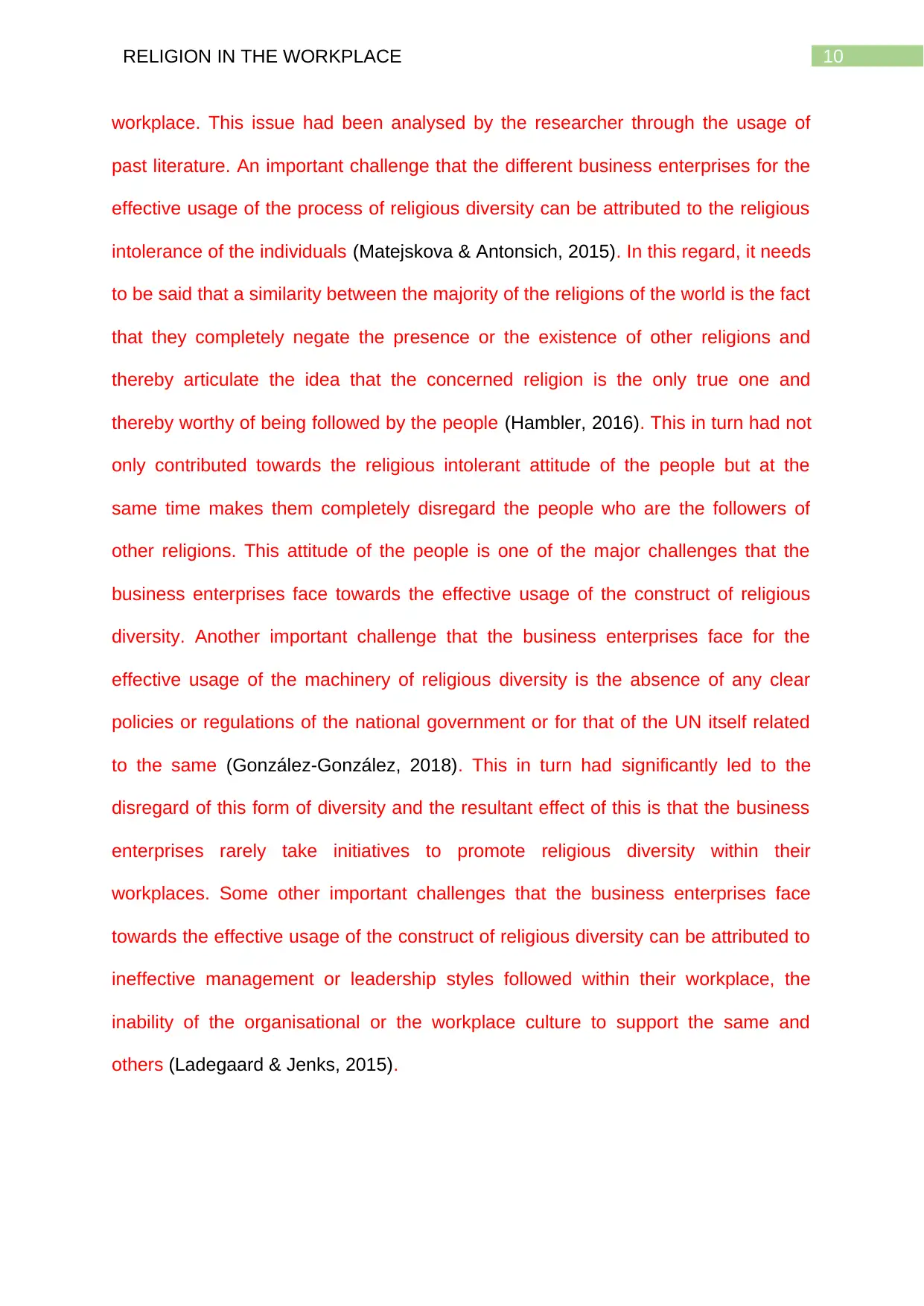
10RELIGION IN THE WORKPLACE
workplace. This issue had been analysed by the researcher through the usage of
past literature. An important challenge that the different business enterprises for the
effective usage of the process of religious diversity can be attributed to the religious
intolerance of the individuals (Matejskova & Antonsich, 2015). In this regard, it needs
to be said that a similarity between the majority of the religions of the world is the fact
that they completely negate the presence or the existence of other religions and
thereby articulate the idea that the concerned religion is the only true one and
thereby worthy of being followed by the people (Hambler, 2016). This in turn had not
only contributed towards the religious intolerant attitude of the people but at the
same time makes them completely disregard the people who are the followers of
other religions. This attitude of the people is one of the major challenges that the
business enterprises face towards the effective usage of the construct of religious
diversity. Another important challenge that the business enterprises face for the
effective usage of the machinery of religious diversity is the absence of any clear
policies or regulations of the national government or for that of the UN itself related
to the same (González-González, 2018). This in turn had significantly led to the
disregard of this form of diversity and the resultant effect of this is that the business
enterprises rarely take initiatives to promote religious diversity within their
workplaces. Some other important challenges that the business enterprises face
towards the effective usage of the construct of religious diversity can be attributed to
ineffective management or leadership styles followed within their workplace, the
inability of the organisational or the workplace culture to support the same and
others (Ladegaard & Jenks, 2015).
workplace. This issue had been analysed by the researcher through the usage of
past literature. An important challenge that the different business enterprises for the
effective usage of the process of religious diversity can be attributed to the religious
intolerance of the individuals (Matejskova & Antonsich, 2015). In this regard, it needs
to be said that a similarity between the majority of the religions of the world is the fact
that they completely negate the presence or the existence of other religions and
thereby articulate the idea that the concerned religion is the only true one and
thereby worthy of being followed by the people (Hambler, 2016). This in turn had not
only contributed towards the religious intolerant attitude of the people but at the
same time makes them completely disregard the people who are the followers of
other religions. This attitude of the people is one of the major challenges that the
business enterprises face towards the effective usage of the construct of religious
diversity. Another important challenge that the business enterprises face for the
effective usage of the machinery of religious diversity is the absence of any clear
policies or regulations of the national government or for that of the UN itself related
to the same (González-González, 2018). This in turn had significantly led to the
disregard of this form of diversity and the resultant effect of this is that the business
enterprises rarely take initiatives to promote religious diversity within their
workplaces. Some other important challenges that the business enterprises face
towards the effective usage of the construct of religious diversity can be attributed to
ineffective management or leadership styles followed within their workplace, the
inability of the organisational or the workplace culture to support the same and
others (Ladegaard & Jenks, 2015).
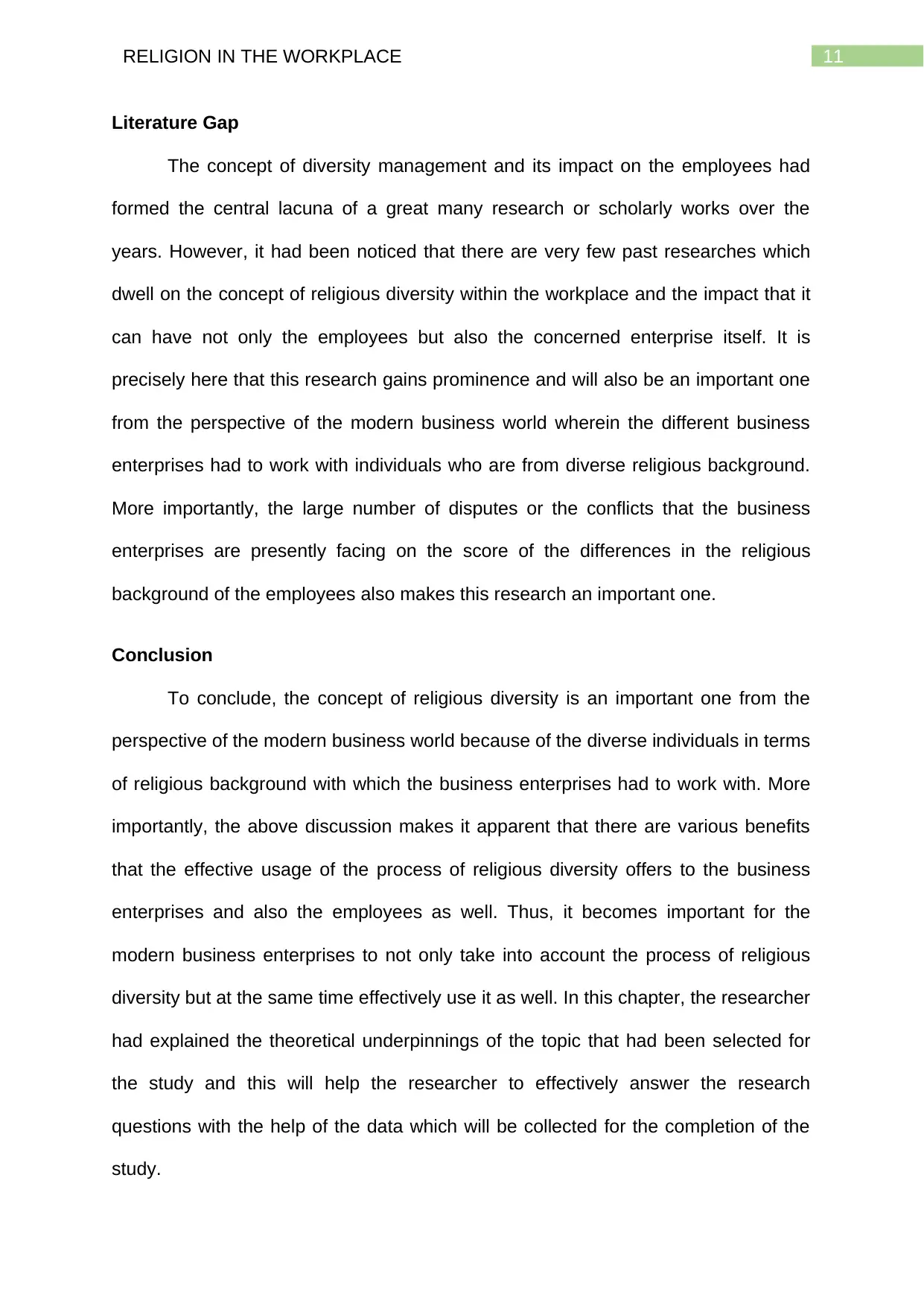
11RELIGION IN THE WORKPLACE
Literature Gap
The concept of diversity management and its impact on the employees had
formed the central lacuna of a great many research or scholarly works over the
years. However, it had been noticed that there are very few past researches which
dwell on the concept of religious diversity within the workplace and the impact that it
can have not only the employees but also the concerned enterprise itself. It is
precisely here that this research gains prominence and will also be an important one
from the perspective of the modern business world wherein the different business
enterprises had to work with individuals who are from diverse religious background.
More importantly, the large number of disputes or the conflicts that the business
enterprises are presently facing on the score of the differences in the religious
background of the employees also makes this research an important one.
Conclusion
To conclude, the concept of religious diversity is an important one from the
perspective of the modern business world because of the diverse individuals in terms
of religious background with which the business enterprises had to work with. More
importantly, the above discussion makes it apparent that there are various benefits
that the effective usage of the process of religious diversity offers to the business
enterprises and also the employees as well. Thus, it becomes important for the
modern business enterprises to not only take into account the process of religious
diversity but at the same time effectively use it as well. In this chapter, the researcher
had explained the theoretical underpinnings of the topic that had been selected for
the study and this will help the researcher to effectively answer the research
questions with the help of the data which will be collected for the completion of the
study.
Literature Gap
The concept of diversity management and its impact on the employees had
formed the central lacuna of a great many research or scholarly works over the
years. However, it had been noticed that there are very few past researches which
dwell on the concept of religious diversity within the workplace and the impact that it
can have not only the employees but also the concerned enterprise itself. It is
precisely here that this research gains prominence and will also be an important one
from the perspective of the modern business world wherein the different business
enterprises had to work with individuals who are from diverse religious background.
More importantly, the large number of disputes or the conflicts that the business
enterprises are presently facing on the score of the differences in the religious
background of the employees also makes this research an important one.
Conclusion
To conclude, the concept of religious diversity is an important one from the
perspective of the modern business world because of the diverse individuals in terms
of religious background with which the business enterprises had to work with. More
importantly, the above discussion makes it apparent that there are various benefits
that the effective usage of the process of religious diversity offers to the business
enterprises and also the employees as well. Thus, it becomes important for the
modern business enterprises to not only take into account the process of religious
diversity but at the same time effectively use it as well. In this chapter, the researcher
had explained the theoretical underpinnings of the topic that had been selected for
the study and this will help the researcher to effectively answer the research
questions with the help of the data which will be collected for the completion of the
study.

12RELIGION IN THE WORKPLACE
Paraphrase This Document
Need a fresh take? Get an instant paraphrase of this document with our AI Paraphraser
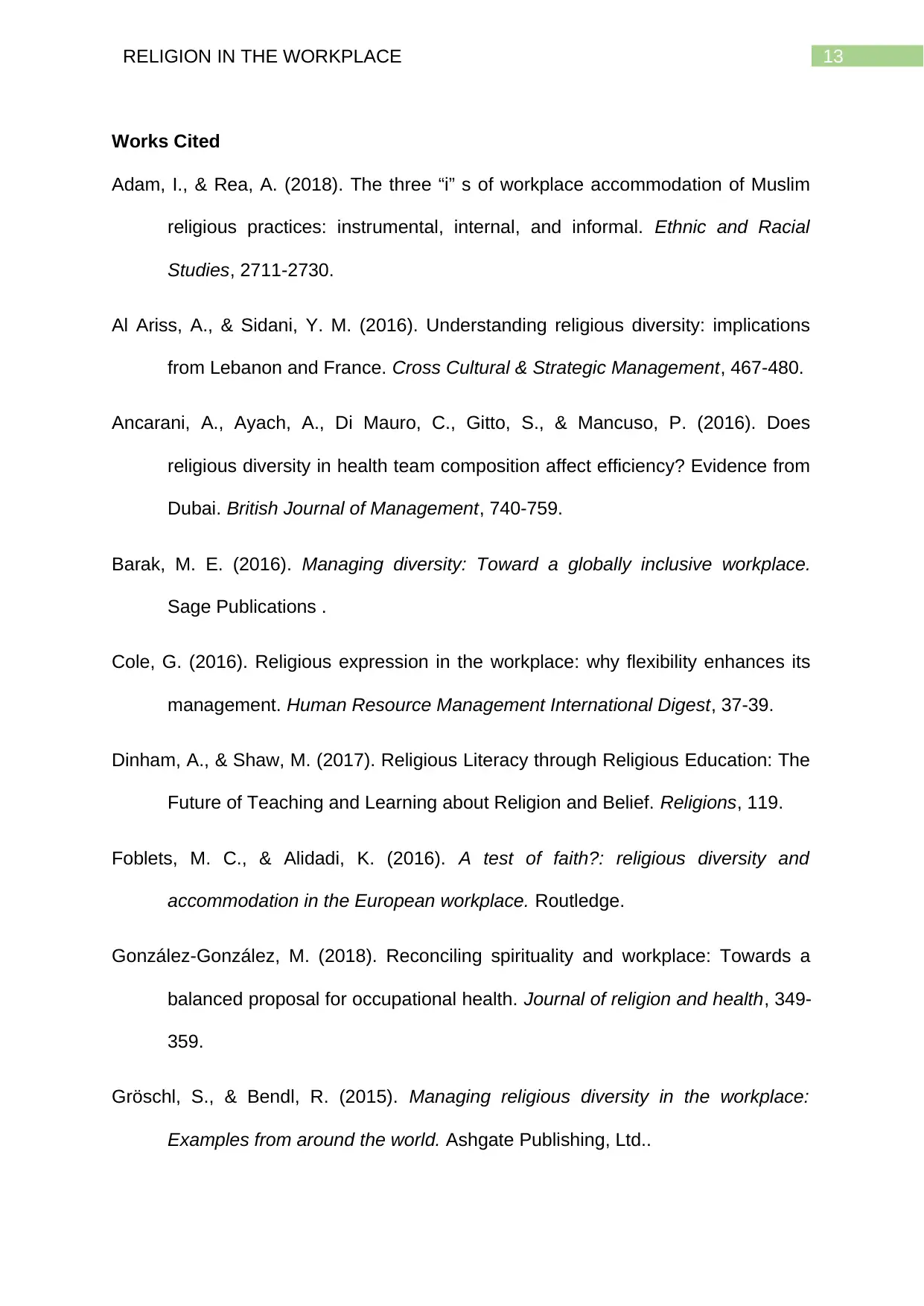
13RELIGION IN THE WORKPLACE
Works Cited
Adam, I., & Rea, A. (2018). The three “i” s of workplace accommodation of Muslim
religious practices: instrumental, internal, and informal. Ethnic and Racial
Studies, 2711-2730.
Al Ariss, A., & Sidani, Y. M. (2016). Understanding religious diversity: implications
from Lebanon and France. Cross Cultural & Strategic Management, 467-480.
Ancarani, A., Ayach, A., Di Mauro, C., Gitto, S., & Mancuso, P. (2016). Does
religious diversity in health team composition affect efficiency? Evidence from
Dubai. British Journal of Management, 740-759.
Barak, M. E. (2016). Managing diversity: Toward a globally inclusive workplace.
Sage Publications .
Cole, G. (2016). Religious expression in the workplace: why flexibility enhances its
management. Human Resource Management International Digest, 37-39.
Dinham, A., & Shaw, M. (2017). Religious Literacy through Religious Education: The
Future of Teaching and Learning about Religion and Belief. Religions, 119.
Foblets, M. C., & Alidadi, K. (2016). A test of faith?: religious diversity and
accommodation in the European workplace. Routledge.
González-González, M. (2018). Reconciling spirituality and workplace: Towards a
balanced proposal for occupational health. Journal of religion and health, 349-
359.
Gröschl, S., & Bendl, R. (2015). Managing religious diversity in the workplace:
Examples from around the world. Ashgate Publishing, Ltd..
Works Cited
Adam, I., & Rea, A. (2018). The three “i” s of workplace accommodation of Muslim
religious practices: instrumental, internal, and informal. Ethnic and Racial
Studies, 2711-2730.
Al Ariss, A., & Sidani, Y. M. (2016). Understanding religious diversity: implications
from Lebanon and France. Cross Cultural & Strategic Management, 467-480.
Ancarani, A., Ayach, A., Di Mauro, C., Gitto, S., & Mancuso, P. (2016). Does
religious diversity in health team composition affect efficiency? Evidence from
Dubai. British Journal of Management, 740-759.
Barak, M. E. (2016). Managing diversity: Toward a globally inclusive workplace.
Sage Publications .
Cole, G. (2016). Religious expression in the workplace: why flexibility enhances its
management. Human Resource Management International Digest, 37-39.
Dinham, A., & Shaw, M. (2017). Religious Literacy through Religious Education: The
Future of Teaching and Learning about Religion and Belief. Religions, 119.
Foblets, M. C., & Alidadi, K. (2016). A test of faith?: religious diversity and
accommodation in the European workplace. Routledge.
González-González, M. (2018). Reconciling spirituality and workplace: Towards a
balanced proposal for occupational health. Journal of religion and health, 349-
359.
Gröschl, S., & Bendl, R. (2015). Managing religious diversity in the workplace:
Examples from around the world. Ashgate Publishing, Ltd..
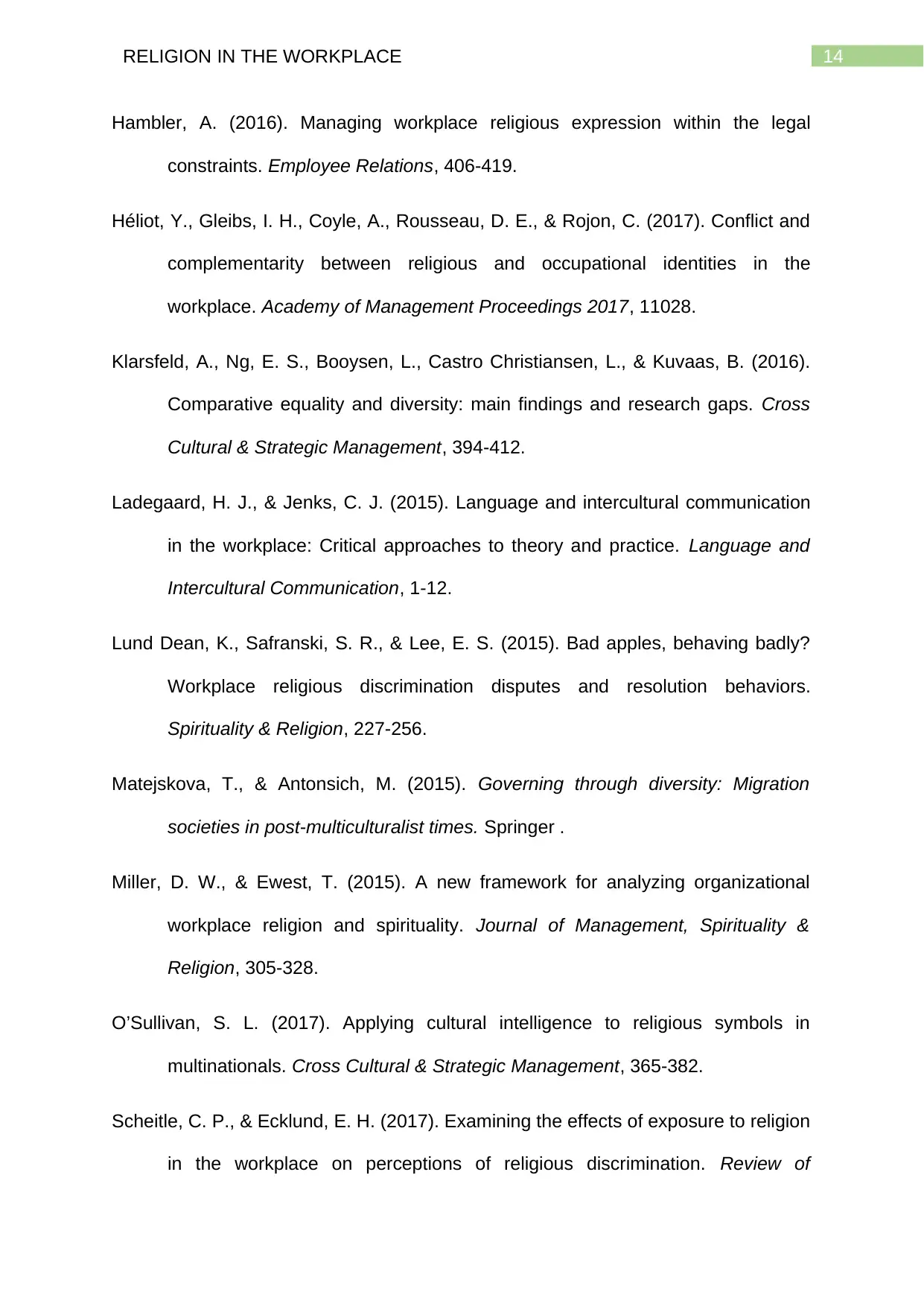
14RELIGION IN THE WORKPLACE
Hambler, A. (2016). Managing workplace religious expression within the legal
constraints. Employee Relations, 406-419.
Héliot, Y., Gleibs, I. H., Coyle, A., Rousseau, D. E., & Rojon, C. (2017). Conflict and
complementarity between religious and occupational identities in the
workplace. Academy of Management Proceedings 2017, 11028.
Klarsfeld, A., Ng, E. S., Booysen, L., Castro Christiansen, L., & Kuvaas, B. (2016).
Comparative equality and diversity: main findings and research gaps. Cross
Cultural & Strategic Management, 394-412.
Ladegaard, H. J., & Jenks, C. J. (2015). Language and intercultural communication
in the workplace: Critical approaches to theory and practice. Language and
Intercultural Communication, 1-12.
Lund Dean, K., Safranski, S. R., & Lee, E. S. (2015). Bad apples, behaving badly?
Workplace religious discrimination disputes and resolution behaviors.
Spirituality & Religion, 227-256.
Matejskova, T., & Antonsich, M. (2015). Governing through diversity: Migration
societies in post-multiculturalist times. Springer .
Miller, D. W., & Ewest, T. (2015). A new framework for analyzing organizational
workplace religion and spirituality. Journal of Management, Spirituality &
Religion, 305-328.
O’Sullivan, S. L. (2017). Applying cultural intelligence to religious symbols in
multinationals. Cross Cultural & Strategic Management, 365-382.
Scheitle, C. P., & Ecklund, E. H. (2017). Examining the effects of exposure to religion
in the workplace on perceptions of religious discrimination. Review of
Hambler, A. (2016). Managing workplace religious expression within the legal
constraints. Employee Relations, 406-419.
Héliot, Y., Gleibs, I. H., Coyle, A., Rousseau, D. E., & Rojon, C. (2017). Conflict and
complementarity between religious and occupational identities in the
workplace. Academy of Management Proceedings 2017, 11028.
Klarsfeld, A., Ng, E. S., Booysen, L., Castro Christiansen, L., & Kuvaas, B. (2016).
Comparative equality and diversity: main findings and research gaps. Cross
Cultural & Strategic Management, 394-412.
Ladegaard, H. J., & Jenks, C. J. (2015). Language and intercultural communication
in the workplace: Critical approaches to theory and practice. Language and
Intercultural Communication, 1-12.
Lund Dean, K., Safranski, S. R., & Lee, E. S. (2015). Bad apples, behaving badly?
Workplace religious discrimination disputes and resolution behaviors.
Spirituality & Religion, 227-256.
Matejskova, T., & Antonsich, M. (2015). Governing through diversity: Migration
societies in post-multiculturalist times. Springer .
Miller, D. W., & Ewest, T. (2015). A new framework for analyzing organizational
workplace religion and spirituality. Journal of Management, Spirituality &
Religion, 305-328.
O’Sullivan, S. L. (2017). Applying cultural intelligence to religious symbols in
multinationals. Cross Cultural & Strategic Management, 365-382.
Scheitle, C. P., & Ecklund, E. H. (2017). Examining the effects of exposure to religion
in the workplace on perceptions of religious discrimination. Review of
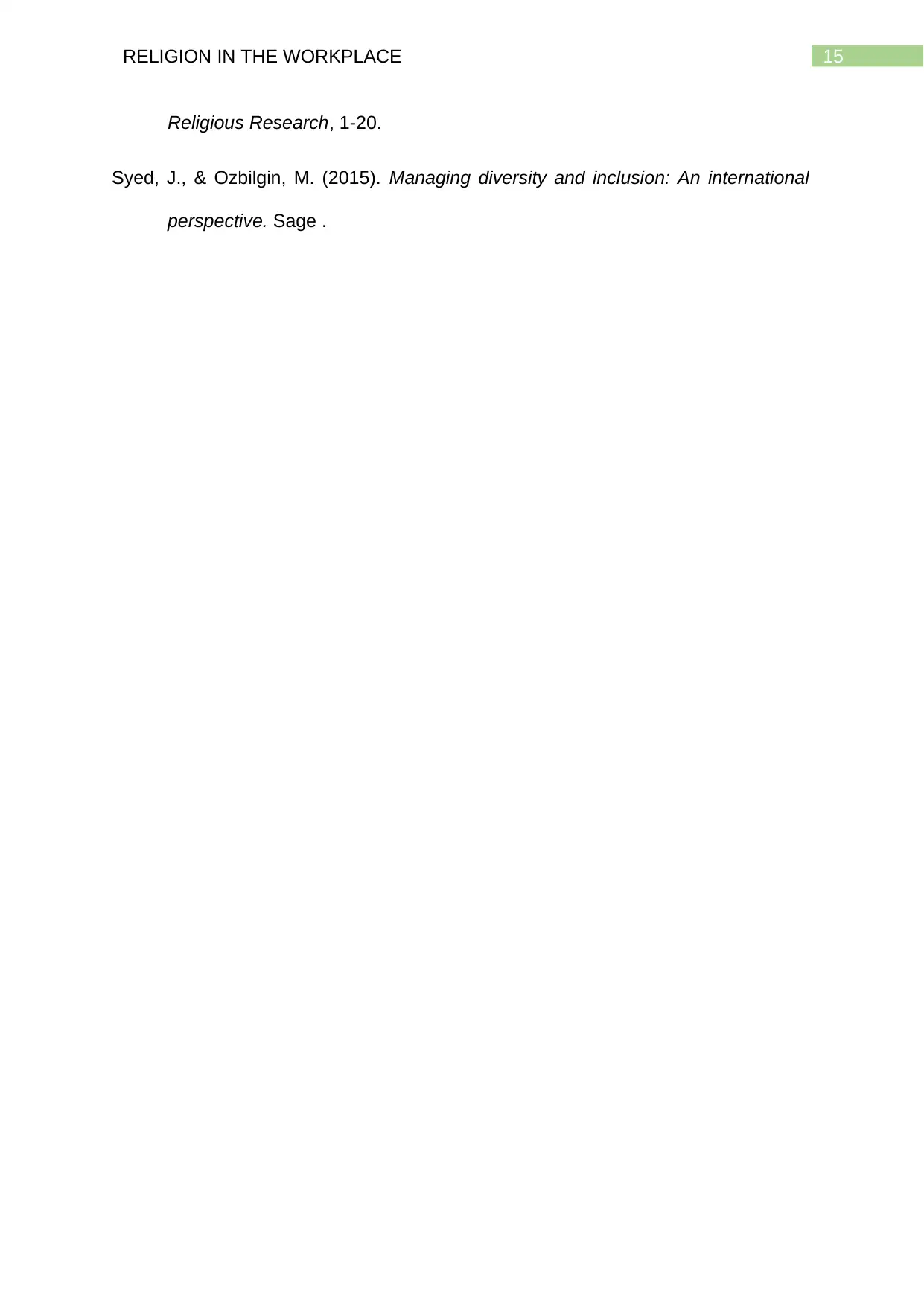
15RELIGION IN THE WORKPLACE
Religious Research, 1-20.
Syed, J., & Ozbilgin, M. (2015). Managing diversity and inclusion: An international
perspective. Sage .
Religious Research, 1-20.
Syed, J., & Ozbilgin, M. (2015). Managing diversity and inclusion: An international
perspective. Sage .
1 out of 16
Related Documents
Your All-in-One AI-Powered Toolkit for Academic Success.
+13062052269
info@desklib.com
Available 24*7 on WhatsApp / Email
![[object Object]](/_next/static/media/star-bottom.7253800d.svg)
Unlock your academic potential
© 2024 | Zucol Services PVT LTD | All rights reserved.





